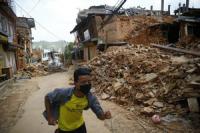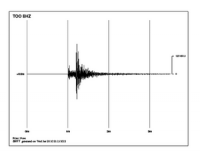-
Predicting floods, hurricanes with social media

Social media can warn us about hurricanes, storms, and floods before they happen – according to new research. Key words and photos on social media can signal developing risks – like water levels rising before a flood. Researchers, who analyzed posts on Flickr between 2004 and 2014, found certain words – such as river, water, and landscape - take on distinct meaning of forecast and warning during time periods leading to extreme weather events. Words can be used as ‘social sensors’, to create accurate early warning system for extreme weather, alongside physical sensors.
-
-
Better communication key to reducing earthquake death toll

A major problem in conveying earthquake risks to the public is that scientists are unable to predict when, where, and with what strength the next earthquake will strike. Instead, they use probabilistic forecasting based on seismic clustering. Earthquake experts have long grappled with the problem of how to convey these complex probabilities to lay persons.
-
-
Quake-detection app recorded nearly 400 temblors worldwide

UC Berkeley’s worldwide network of smartphone earthquake detectors has recorded nearly 400 earthquakes since the MyShake app was made available for download in February, with one of the most active areas of the world the fracking fields of Oklahoma. The Android app harnesses a smartphone’s motion detectors to measure earthquake ground motion, then sends that data back to the Berkeley Seismological Laboratory for analysis. The eventual goal is to send early-warning alerts to users a bit farther from ground zero, giving them seconds to a minute of warning that the ground will start shaking.
-
-
May 2012 North Korean seismic event an earthquake, not nuclear test
A tiny seismic event that occurred in North Korea on 12 May 2010 appears to have been an earthquake rather than a small underground nuclear explosion, according to a new analysis. The new study contradicts the findings of a 2015 report which concluded that the magnitude 1.5 seismic 12 May event was a small nuclear explosion.
-
-
Japan’s latest tsunami reaction shows lessons learned from previous disasters
Parts of Japan were on tsunami alert today following a magnitude 6.9 earthquake off the east coast of the country. This was the first real test for Japan since the 2011 earthquake which led to a deadly tsunami. The lessons learned from 2011 saw higher seawalls, more effective public education and evacuation protocols, a beefed-up response from the nuclear industry and so on, but would it pass the test? The good news is that Japan came through this with flying colors. It wasn’t long after the earthquake hit that the tsunami warnings were later downgraded. Undoubtedly there will have been one or two glitches, but the tsunami was managed well by a country that has experienced more of these events that any of us would ever like to contemplate.
-
-
Bathroom air freshener triggers emergency response at nuclear weapons complex
Late in the afternoon on Wednesday of last week officials at the nuclear weapons complex declared an emergency after finding what they regarded as a suspicious device in a bathroom at the Savannah River National Laboratory in South Carolina. Emergency teams determined that the suspicious device was an air freshener wrapped in paper towels with a flashing light on it.
-
-
Thousands of people didn’t evacuate before Hurricane Matthew. Why not?
As Hurricane Matthew approached the Atlantic coast earlier this month, many residents followed orders to evaqcuate, but others stayed in place. Hurricane Matthew illustrates the challenges of managing disaster evacuations effectively. By understanding who is likely to obey or ignore evacuation orders, authorities can use data to reduce the number of false alarms and concentrate limited resources on groups who are most likely to choose to shelter in place. It is critical to grapple with these issues so we can do a better job responding to the next storm, which likely won’t be ten years away.
-
-
“Drop, Cover, and Hold On”: Worldwide ShakeOut drill to be held 20 October
USGS scientists recently determined that nearly half of Americans are exposed to potentially damaging earthquakes based on where they work and live. Still others will be at risk when traveling. USGS asks Americans to be prepared to join millions of people from around the world participating in Great ShakeOut Earthquake Drills worldwide on 20 October. During the drill, participants practice “Drop, Cover, and Hold On.” This is the recommended safety action to take during an earthquake.
-
-
FCC updates, strengthens Wireless Emergency Alerts (WEA)
The Federal Communications Commission (FCC) two weeks ago adopted rules to update and strengthen Wireless Emergency Alerts (WEA), a system that delivers critical warnings and information to Americans on their wireless phones. The updated rules are intended to promote the wider use and effectiveness of this lifesaving service, especially for state and local authorities to convey important information to their communities.
-
-
High-tech early warning system for hurricanes, tornados, and volcanic eruptions
Earlier this year, the Laser Interferometer Gravitational-Wave Observatory (LIGO) was able to detect a gravity wave wafting through space from two colliding black holes billions of years ago. Now a group of researchers has built a much smaller ring laser interferometer to explore how it could detect geophysical effects such as earthquake-generated ground rotation and infrasound from convective storms and have demonstrated the technology’s potential as an early-warning system for natural disasters.
-
-
Can we get better at predicting earthquakes?
In the wake of the deadly earthquake, measuring 6.2, which rocked central Italy in the early hours of 24 August, questions again have been raised about whether earthquakes can be predicted. Fortunately, all earthquakes do not lead to disasters and, therefore, understanding where and why disasters are produced is the first goal of earthquake seismology. The first issue is thus one of semantics and objectives. Is the goal to predict an earthquake occurrence, predict ground motion due to an earthquake, or predict a disaster? In our efforts to better predict earthquakes, we have to be precise about the timescale: is it a prediction that an earthquake is imminent – that is, within seconds, hours, or even days before the shaking? Or that it is likely to happen within years or tens of years? There is hope that one day we could detect and monitor extremely slight changes in the rocks that would precede earthquakes – but this is still a long way from “prediction” of precisely when and where a disaster will occur. For now, knowing earthquakes is one way to live with them, to be prepared, to know the vulnerability of our communities and to adopt sound policies for earthquake-safe environments.
-
-
USGS awards $3.7 million to advance ShakeAlert early warning system
The U.S. Geological Survey awarded approximately $3.7 million to six universities to support transitioning the ShakeAlert earthquake early warning system into a production system. Additionally, the USGS has purchased about $1.5 million in new sensor equipment to expand and improve the ShakeAlert system and awarded about $0.25 million in supplements to earlier agreements to three universities. These efforts, as well as internal work that the USGS is conducting, are possible because of $8.2 million in funding to the USGS Earthquake Hazards Program for ShakeAlert approved by Congress earlier this year.
-
-
Connecticut launches emergency alert mobile app for state residents
Connecticut governor Dannel P. Malloy last week announced the launch of a new emergency preparedness mobile application for Connecticut residents. The app provides information and alerts in emergency situation, and also helps residents prepare in advance of an emergency. The CT Prepares app, which can be downloaded to most smartphones, incorporates and integrates text messaging, e-mail, and social networking, allowing residents to communicate with family members during an emergency.
-
-
SayVU security app – developed by a BGU graduate student -- deployed at Rio Olympics

A new app, SayVU, conceived as a graduate student project at Ben-Gurion University of the Negev, is being deployed at the 2016 Rio Olympics. International Security & Defense Systems (ISDS), the security integrator for the Olympics, selected SayVU as one of the Israeli technologies being used to protect attendees. SayVU enables a user to send a distress signal to an emergency hotline even if a phone is locked and without having to access the application. The message can be sent in a number of ways; shaking the device, tapping the camera button, or simply speaking into the phone.
-
-
False earthquake smartphone alert sends Japanese into panic
Thousands of Tokyo residents were sent into panic by an erroneous alert that a massive earthquake had hit the Japanese capital. The alert also disrupted some train services. The Japanese Meteorological Agency issued, and then sent, the alert just after 5 p.m., saying a magnitude-9.1 quake had struck the city. The agency cancelled the alert a few seconds later, but tens of thousands of smartphone owners who subscribe to the popular Yurekuru disaster warning app had already received the alert.
-
- All
- Regional
- Water
- Biometrics
- Borders/Immig
- Business
- Cybersecurity
- Detection
- Disasters
- Government
- Infrastructure
- International
- Public health
- Public Safety
- Communication interoperabillity
- Emergency services
- Emergency medical services
- Fire
- First response
- IEDs
- Law Enforcement
- Law Enforcement Technology
- Military technology
- Nonlethal weapons
- Nuclear weapons
- Personal protection equipment
- Police
- Notification /alert systems
- Situational awareness
- Weapons systems
- Sci-Tech
- Sector Reports
- Surveillance
- Transportation
Advertising & Marketing: advertise@newswirepubs.com
Editorial: editor@newswirepubs.com
General: info@newswirepubs.com
2010-2011 © News Wire Publications, LLC News Wire Publications, LLC
220 Old Country Road | Suite 200 | Mineola | New York | 11501
Permissions and Policies
Editorial: editor@newswirepubs.com
General: info@newswirepubs.com
2010-2011 © News Wire Publications, LLC News Wire Publications, LLC
220 Old Country Road | Suite 200 | Mineola | New York | 11501
Permissions and Policies
